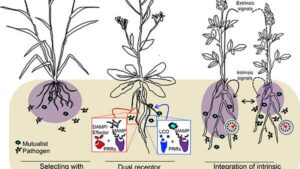Research conducted by the John Innes Centre reveals that different types of barley attract unique communities of soil microbes to grow around their roots. This is achieved through the release of a tailored mixture of sugars and other compounds.
Beneficial soil microbes, residing on or around plant roots, play crucial roles in providing nutrition, enhancing the plant’s stress tolerance, and safeguarding it from pathogenic microbes, according to a press release.
In return, the plant exudes a portion of the sugars produced via photosynthesis, along with amino acids and other metabolites, into its surrounding environment. The variety of soil microbes attracted by a plant can vary significantly, depending on the types of compounds the plant emits.
In the new study which appears in PLOS Biology, researchers in the group of Dr. Jacob Malone at the John Innes Centre took a closer look at the relationship between a plant’s genetics and its root microbes.
The researchers examined the microbiomes of two barley plant varieties: Tipple, a modern type, and Chevallier, a traditional type. While both barley types shared a core group of microbes associated with their roots, there were notable differences in their overall microbial communities.
One common group of root microbes – the Pseudomonas genus – was significantly more abundant around the roots of Tipple plants. This abundance was attributed to Tipple plants secreting large quantities of sugars known as hexoses (such as glucose or fructose), which are particularly preferred by Pseudomonas.
Furthermore, the researchers observed differences in gene activity between the two barley varieties, which helped to elucidate the variations in their root communities. When the researchers attempted to exchange the microbial communities between the two types of barley, each barley variety exhibited better growth when exposed to its original microbial community.
The release notes that the findings suggest that plants can fine-tune the population of microbes colonizing its root zone, which can have important outcomes for plant health.
Although these findings were based on plants cultivated in greenhouses, researchers emphasized that assessing the extent of these differences in barley grown in farm fields will pose a significant challenge for future research.
“Our research shows that different barley varieties recruit distinct microbial communities from the soil, based on the sugars and other nutrients they secrete from their roots,” Malone said. “These microbes help some varieties to grow but not others, suggesting that breeding cereals to recruit beneficial, growth promoting microbes may be possible in the future.”
The study appears in PLOS Biology.













